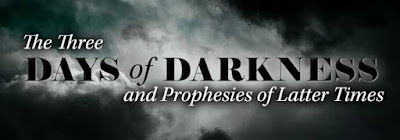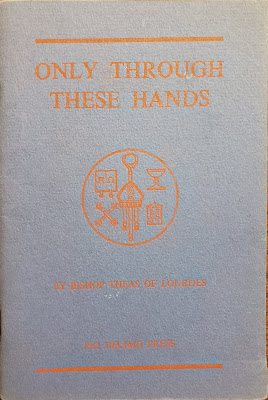Divine Intimacy by Fr. Gabriel of Saint Mary Magdalen provides deeply enriching spiritual commentary in line with the Carmelite spirituality. It is organized based on the Traditional readings for the Sunday Gospels and around the seasonal themes in the liturgical year. Yet the meditations often are appropriate for any day as they center on true spiritual progress. Divine Intimacy has received great accolades from people who I personally know read from it. The Liturgy Guy provides a very good review of Divine Intimacy where he says in part: "The brilliance of Divine Intimacy comes from Fr. Gabriel’s unique ability to balance spiritual depth with literary brevity: each daily entry typically is no more than three pages long. However, within those few pages, the reader is invited to seek God through the direction of Fr. Gabriel."
As stated on the product listing at Baronius Press: "This Book of Meditations is a classic and is seeped in Carmelite spirituality. For every day it offers two meditations, in liturgical arrangement, that enable the soul to enter the conscious presence of God and to reflect on the theme of the day. These are followed by a ‘Colloquy’ that helps the person at prayer to start a friendly conversation with God where acts of praise and love, petition, and thanksgiving are made, together with good resolutions for the future. Here we are at the very heart of prayer, which is a heart-to-heart encounter in faith with the living God. Divine Intimacy is the highest state attainable on earth. In this union of love, the soul produces acts of love which have an immense apostolic influence on a multitude of souls. This knowledge of the ways that lead to God, according to the teaching of the renowned Spanish mystics, is distilled into the pages of this book."
Daily Breviary Meditations by Bishop Angrisani are a 4 volume set that follows the Traditional (pre-1955 Catholic liturgical year). These daily meditations tend to follow the cycle of readings in Matins and are heavily geared toward the clergy. However, the meditations here are certainly still worthwhile for even lay Catholics, especially those who pray the Divine Office.
This reprint from Refuge of Sinners Publishing states: "The extremely important aim of this work, which is the sanctification of the Clergy and laity alike, increases its value and suitableness to the needs of our times. For never before, as in our day, in this period of general disorientation of minds and of most grave threats to the Faith and moral life of the people, has there been felt the necessity of holy priests and laity who for the salvation of Christian civilization must constitute an impenetrable barrier to the onslaughts of impiety and evil customs. This is a rare work that will be a valuable asset to any library." A sample image from a page of the meditations may be viewed here.
The Church's Year by Fr. Leonard Goffine is also worth mentioning. While not a "daily" source of meditations, Fr. Goffine's work includes explanations on the Epistles and Gospel readings for all Sundays and holy days. He includes other explanations of Church doctrine and ecclesiastical customs throughout as well. The meditations can certainly serve worthwhile to be read throughout the year - not just on the particular Sunday he has assigned them. The website for the SSPX Asia has the work available to read freely online.
Dom Gueranger's Liturgical Year is the gold standard when it comes to insights, spiritual enrichment, and historical information on the Traditional Liturgical Year. In fact, his "Liturgical Year" would influence Fr. Pius Parsch who is mentioned further down this list with a work of his own.
This 15 volume set is described as follows on the product page: "This monumental liturgical work, comprising fifteen volumes, was the life-long labor of Benedictine Abbot Dom Guéranger. Written with the heart of a seraphic contemplative, the holy abbot takes the reader on a daily spiritual pilgrimage through the liturgies of both the East and the West as he immerses the soul into the very life of the ecclesia orans et adorans (the church praying and adoring). The author achieves this by providing daily entries corresponding to the yearly cycle of the Church's worship in both her divine seasonal feasts and those of her saints. Each day begins with a rich and provocative meditation on the mystery of faith to be celebrated together with the ecclesial history of the same; this is followed by excerpts from the Roman Missal's Mass of the day (complete with Propers, i.e., Introits, Collects, Offertory prayers, etc ) as well a host of exquisite hymns from the divine office which are coupled with varied and sundry sequences garnered from other ancient Catholic rites."
The FSSP Apostolate in Atlanta has a free email subscription to Dom Gueranger's liturgical year. Sign up to receive the daily meditation using the pre-1955 calendar that was in place at the time of Dom Gueranger's writing. In fact, his writings precede even the liturgical changes of Pope St. Pius X. While the volume does include the feasts added to the liturgical calendar in the early 1900s, it is still a true gem and one that I read through every morning.
Also worth mentioning are the Sermons on the liturgy for Sundays and feast days by Fr. Pius Parsch. Fr. Parsch was a leading figure in the Liturgical Movement in the early 1900s and his works "The Liturgy of the Mass" (1940) and "The Breviary Explained" (1952) are still read. Fr. Parsch was unfortunately a promoter of the liturgical trend to celebrating Mass on a table while facing the people away from the tabernacle. He died in 1954.
While these are not "daily meditations" Fr. Parsch provides really insightful and meaningful commentary on the Mass texts. No modernism here in the five Sunday entries I have read thus far. More than merely discussing the Gospel reading, he provides holistic commentary on the Mass texts as a whole, often providing historical context and going much deeper and on different topics than discussed in most other commentaries. I've personally been using it every Sunday and highly recommend it. For a sample, see my Facebook post where I shared pictures of his meditation for the 14th Sunday after Pentecost.
And lastly, I highly recommend the CatechismClass.com course on the Liturgical Year. With various lessons on the feast days and fast days throughout the liturgical year, it is a great resource. The lessons combined Scripture, traditional catechism passages, prayers, devotions, activities, saintly writing, and other sources in a way that other commentaries cannot do. Again, while they do not have lessons for every single day in the year - or all Sundays - they do have a wide range of lessons, covering saints for instance like St. Jeanne Jugan, who are not covered in any other work mentioned on this list.























